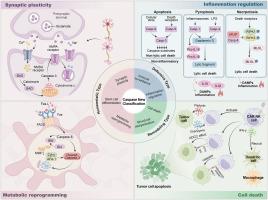The multifunctionality of the caspase family of proteases: A new perspective beyond cell death
IF 10.3
2区 医学
Q1 BIOCHEMISTRY & MOLECULAR BIOLOGY
引用次数: 0
Abstract
Caspase family proteases, as aspartate-specific cysteine proteases, have long been considered to function exclusively in programmed cell death. However, emerging evidence indicates that their functions extends well beyond apoptosis. Members of this family exhibit numerous non-cell death functions through dynamic regulation of activity gradients and spatiotemporal localization, participating extensively in physiological processes such as neuronal synaptic remodeling, immune homeostasis regulation, and metabolic reprogramming, thereby forming a functional continuum from the molecular to the system level. Based on these novel functions, we propose a function-oriented classification of caspases into three categories: homeostatic, defensive, and remodeling types, while revealing their cross-category functional overlap. In addition, the development of conformation-specific inhibitors and microenvironment-responsive delivery systems provides precise regulatory tools for targeted therapy. This paper systematically summarizes the non-apoptotic functions of the caspase family and proposes a "spatiotemporal activity" dynamic model, opening new avenues for tumor therapy, neurodegenerative disease intervention, and immune disorder regulation.

caspase蛋白酶家族的多功能性:超越细胞死亡的新视角。
Caspase家族蛋白酶作为天冬氨酸特异性半胱氨酸蛋白酶,长期以来被认为只在程序性细胞死亡中起作用。然而,新出现的证据表明,它们的功能远远超出了细胞凋亡。该家族成员通过动态调节活动梯度和时空定位表现出多种非细胞死亡功能,广泛参与神经突触重塑、免疫稳态调节和代谢重编程等生理过程,从而形成从分子到系统水平的功能连续体。基于这些新功能,我们将半胱天冬酶分为三类:稳态型、防御型和重塑型,同时揭示了它们的跨类别功能重叠。此外,构象特异性抑制剂和微环境响应递送系统的发展为靶向治疗提供了精确的调节工具。本文系统总结了caspase家族的非凋亡功能,提出了caspase家族的“时空活动”动态模型,为肿瘤治疗、神经退行性疾病干预、免疫失调调节等开辟了新的途径。
本文章由计算机程序翻译,如有差异,请以英文原文为准。
求助全文
约1分钟内获得全文
求助全文
来源期刊

Molecular Aspects of Medicine
医学-生化与分子生物学
CiteScore
18.20
自引率
0.00%
发文量
85
审稿时长
55 days
期刊介绍:
Molecular Aspects of Medicine is a review journal that serves as an official publication of the International Union of Biochemistry and Molecular Biology. It caters to physicians and biomedical scientists and aims to bridge the gap between these two fields. The journal encourages practicing clinical scientists to contribute by providing extended reviews on the molecular aspects of a specific medical field. These articles are written in a way that appeals to both doctors who may struggle with basic science and basic scientists who may have limited awareness of clinical practice issues. The journal covers a wide range of medical topics to showcase the molecular insights gained from basic science and highlight the challenging problems that medicine presents to the scientific community.
 求助内容:
求助内容: 应助结果提醒方式:
应助结果提醒方式:


